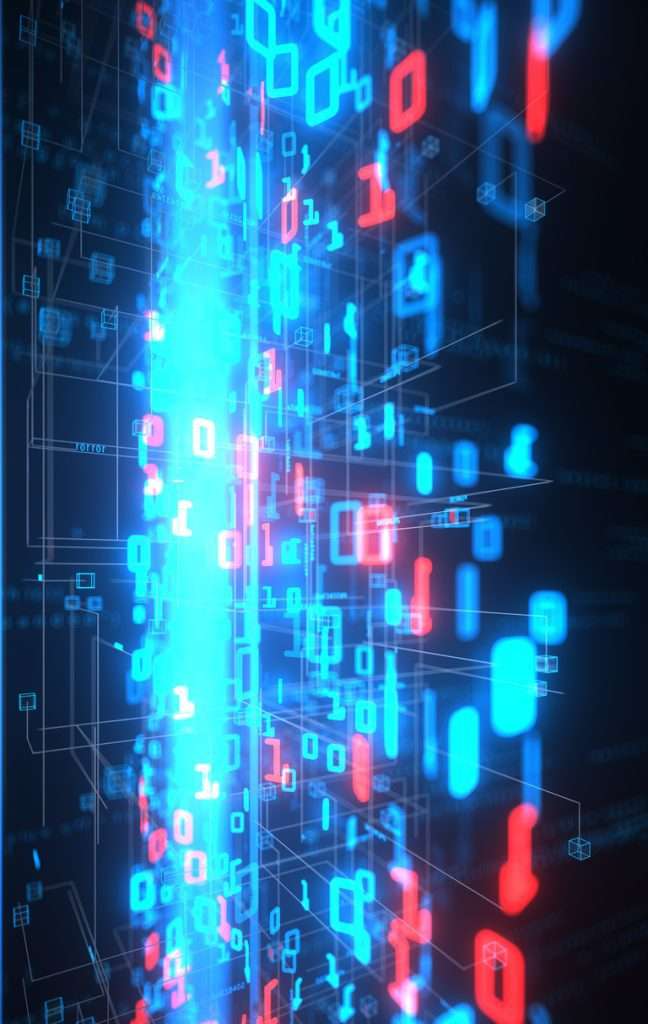Cloud technology is the delivery of computing services including servers, storage, databases, networking, software, analytics, intelligence, and more over the Internet or “the cloud” to offer faster innovation, flexible resources, and economies of scale.
Innovations in cloud technology are accelerating the growth of digital transformation, as companies invest and operate in the cloud to mitigate or eliminate tech discrepancies, keep pace with changing consumer demands, and survive in the face of the digital-first future.
The future of cloud computing is bright, with the global market projected to grow from $1 trillion in 2023 to over $2.3 trillion by 2032. Businesses should be aware of the latest cloud computing trends and how they can leverage them to improve their operations and competitiveness.
Edge Computing
Edge computing is a distributed computing paradigm that brings computation and data storage closer to the sources of data, such as IoT devices or local edge servers. This proximity to data at its source can deliver strong business benefits, including faster insights, improved response times, and better bandwidth availability.
Edge computing works by processing data locally on edge devices or edge servers, rather than sending it all the way to a central cloud data centre. This can significantly reduce latency, as data does not have to travel as far to be processed. Edge computing can also help to reduce bandwidth usage, as only the most important data needs to be sent to the cloud.
Some specific examples of edge computing in use include:
- Self-driving cars: Edge computing is used to process sensor data from self-driving cars in real time, enabling them to make quick decisions about how to navigate and avoid obstacles.
- Smart factories: Edge computing is used to monitor and control industrial equipment in smart factories, helping to improve efficiency and reduce downtime.
- Smart cities: Edge computing is used to process data from traffic sensors, cameras, and other devices in smart cities, enabling real-time traffic management, public safety monitoring, and other applications.

AI and ML
Artificial Intelligence (AI) is a field of computer science that focuses on the creation of intelligent agents, which are systems that can reason, learn, and act autonomously. AI systems are typically trained on large amounts of data, which allows them to learn patterns and insights that can be used to make predictions and decisions.
Machine Learning (ML) is a subset of AI that focuses on the development of algorithms that can learn from data without being explicitly programmed. ML algorithms are typically trained on large datasets, which allows them to learn patterns and insights that can be used to make predictions and decisions without the need for human intervention.
AI and ML are integral to cloud computing because they offer cost-effective solutions for data collection and algorithm training. This is because AI and ML algorithms can be trained on massive datasets to learn patterns and insights that would be difficult or impossible to find manually. This can help tech companies to improve their productivity and make better decisions.
Here are some specific examples of how AI and ML are being used in cloud computing today:
- AI-powered chatbots: AI-powered chatbots are used by cloud providers to provide customer support and troubleshoot problems.
- ML-based predictive analytics: ML-based predictive analytics is used by cloud providers to optimize performance, predict demand, and detect fraud.
- AI-powered security: AI-powered security tools are used by cloud providers to detect and respond to security threats.
- ML-based personalised recommendations: ML-based personalised recommendations are used by cloud providers to recommend applications and services to users based on their past usage.
XaaS
XaaS stands for Anything as a Service. It is a broad term that refers to the delivery of any IT service over the internet on a pay-as-you-go basis. XaaS services can include everything from software to infrastructure to hardware to support.
XaaS works by leveraging cloud computing to provide users with access to resources and services on demand. This allows users to avoid the upfront costs and complexity of purchasing and managing their own IT infrastructure.
Here’s how XaaS is used:
- Software as a Service (SaaS): SaaS applications are hosted by a cloud provider and delivered to users over the internet. SaaS applications are typically subscription-based, so users only pay for what they use. Examples of SaaS applications include Google Workspace, Microsoft 365, and Salesforce.
- Platform as a Service (PaaS): PaaS provides users with a platform for developing, deploying, and managing applications. PaaS includes all of the resources needed to run applications, such as servers, storage, and networking. Examples of PaaS platforms include Amazon Web Services (AWS) Elastic Beanstalk, Google App Engine, and Microsoft Azure App Service.
- Infrastructure as a Service (IaaS): IaaS provides users with access to computing resources, such as virtual machines, storage, and networking. IaaS is typically used by businesses and organizations that need to build and manage their own IT infrastructure. Examples of IaaS providers include AWS, Google Cloud Platform, and Microsoft Azure.
- Desktop as a Service (DaaS): DaaS provides users with access to a virtual desktop environment over the internet. This allows users to access their applications and data from anywhere with an internet connection.
- Database as a Service (DBaaS): DBaaS provides users with access to a managed database service. This allows users to avoid the hassle of managing their own database infrastructure.
- Disaster Recovery as a Service (DRaaS): DRaaS provides users with a cloud-based disaster recovery solution. This allows users to recover their data and applications quickly and easily in the event of a disaster.
- Communications as a Service (CaaS): CaaS provides users with cloud-based communications services, such as VoIP, video conferencing, and chat.
- Network as a Service (NaaS): NaaS provides users with a managed network service. This allows users to avoid the hassle of managing their own network infrastructure.
Cloud Computing Disaster Recovery
Cloud computing disaster recovery (CDR) is a strategy that uses cloud-based resources to protect and recover data and applications in the event of a disaster. CDR can help businesses to minimise downtime and disruption to their operations, and to get back up and running quickly.
CDR works by replicating data and applications to a cloud-based environment. This means that if there is a disaster at the primary site, the business can quickly switch to the cloud-based environment and continue operating. CDR can also be used to recover data and applications that have been lost or damaged.
How cloud computing disaster recovery works:
- The business replicates its data and applications to a cloud-based environment.
- In the event of a disaster at the primary site, the business switches to the cloud-based environment.
- The business continues operating from the cloud-based environment until the primary site has been restored.
- Once the primary site has been restored, the business can switch back to the primary site or continue operating from the cloud-based environment.

No-Code and Low-Code Apps
No-code and low-code app development platforms are tools that allow users to create applications without writing any code or with minimal coding skills. These platforms provide a visual interface and pre-built components that can be used to create applications by dragging and dropping components and configuring them to perform specific actions.
How no-code and low-code app development platforms work:
- Visual interface: No-code and low-code platforms provide a visual interface that allows users to design the layout of their application by dragging and dropping components.
- Pre-built components: No-code and low-code platforms provide a library of pre-built components that can be used to create applications. These components can include buttons, text boxes, images, and menus.
- Configuration: Users can configure pre-built components to perform specific actions. For example, a user could configure a button to open a new page when it is clicked.
- Custom code: No-code and low-code platforms also allow users to write custom code. This can be useful for creating more complex applications, or for extending the functionality of pre-built components.
Serverless Computing
Serverless computing is a cloud computing execution model in which the cloud provider allocates machine resources on demand, taking care of the servers on behalf of their customers. It is a product of the sharing economy because it allows businesses to pay for compute resources on an as-needed basis, rather than having to provision and manage their own servers. This can be a significant cost savings for businesses, especially those with variable workloads.
How serverless computing works:
- Developers write code in a programming language of their choice.
- They deploy the code to a cloud provider.
- The cloud provider takes care of all the backend infrastructure, including provisioning servers, scaling the application up or down as needed, and handling security and compliance.
- The cloud provider executes the code in response to events, such as HTTP requests, messages from queues, or changes to data in databases.
Blockchain
Blockchain is a distributed ledger technology that allows for secure, transparent, and tamper-proof transactions. It is a continuously growing list of records, called blocks, which are linked together using cryptography. Each block contains a cryptographic hash of the previous block, a timestamp, and transaction data. This makes it very difficult to alter or delete data on a blockchain without the knowledge and consensus of the entire network.
Blockchains are decentralised, meaning that they are not controlled by any single entity. Instead, they are maintained by a network of computers, called nodes. Each node has a copy of the blockchain ledger, and they work together to verify and validate transactions. This makes blockchains very resistant to fraud and hacking.
Blockchains are also transparent, meaning that all transactions on a blockchain are public and can be viewed by anyone. This transparency makes it difficult to commit fraud or corruption on a blockchain.
Blockchain technology has a wide range of potential applications in a variety of industries, including:
- Finance: Blockchain can be used to create new financial instruments, such as cryptocurrencies and decentralized exchanges. It can also be used to improve the efficiency and transparency of existing financial systems.
- Supply chain management: Blockchain can be used to track the movement of goods throughout a supply chain, from the raw materials supplier to the final customer. This can help to improve transparency and efficiency, and to reduce fraud.
- Healthcare: Blockchain can be used to store and share patient medical records securely. It can also be used to develop new healthcare applications, such as telemedicine and remote patient monitoring.
IoT
The Internet of Things (IoT) is a network of physical devices that are connected to the internet and can collect and exchange data. IoT devices can include anything from smart thermostats and home security systems to industrial sensors and medical devices.
IoT and cloud computing are often used together because they complement each other well. IoT devices can collect large amounts of data, but they often do not have the resources to process and store that data on their own. Cloud computing provides IoT devices with the resources they need to process and store their data, and to make that data accessible to other applications and devices.
Here are some of the ways that IoT and cloud computing are used together:
- Data collection and storage: IoT devices can collect data from their environment, such as temperature, humidity, or motion. This data can then be sent to the cloud for storage and processing.
- Remote monitoring and control: IoT devices can be monitored and controlled remotely using cloud-based applications. This allows businesses to manage their IoT devices from anywhere in the world.
- Data analytics: Cloud-based analytics tools can be used to analyse the data collected by IoT devices. This analysis can be used to improve business processes, identify new opportunities, and make better decisions.
SASE
Secure Access Service Edge (SASE) is a cloud-based security architecture that combines networking and security functions into a single, integrated service. SASE is designed to provide secure access to applications and data for users and devices, regardless of their location.
SASE converges several traditional security functions into a single service, including:
- Cloud access security broker (CASB): CASB provides security and visibility for cloud-based applications and data.
- Firewall as a service (FWaaS): FWaaS provides next-generation firewall protection for both on-premises and cloud-based applications and data.
- Zero trust network access (ZTNA): ZTNA provides secure access to applications and data based on user identity and device context, regardless of network location.
Cloud Security and Resilience
Cloud security and resiliency is the practice of protecting cloud-based data, applications, and infrastructure from cyberattacks and disruptions. It involves implementing a combination of security measures and best practices to ensure that cloud environments are secure, compliant, and available.
Cloud security and resiliency is achieved through a layered approach that includes the following:
- Identity and access management (IAM): IAM controls who has access to cloud resources and what they can do with them.
- Data security: Data security measures protect cloud-based data from unauthorized access, modification, or disclosure.
- Application security: Application security measures protect cloud-based applications from vulnerabilities and attacks.
- Infrastructure security: Infrastructure security measures protect the underlying cloud infrastructure, such as servers, networks, and storage.
- Incident response: Incident response plans ensure that organizations can quickly and effectively respond to cloud security incidents.
Future-Proof Your Enterprise with Intelliworx's Cloud Consulting Services

The cloud computing landscape evolves in 2023 and beyond. You need to stay ahead in the digital revolution and Intelliworx is your strategic partner for future-proofing your business. Contact us today to learn more.








